Hands On with USB Type C: Reversible USB Connectors
by Joshua Ho on September 11, 2014 9:00 AM EST- Posted in
- Smartphones
- Mobile
- Laptops
- Tablets
- USB-IF
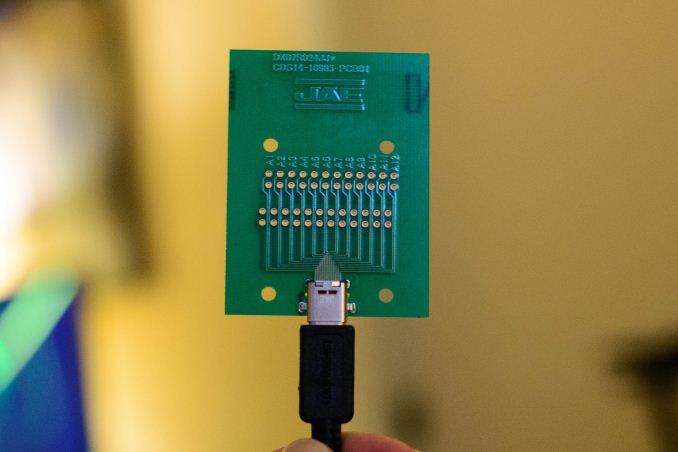
Today, the USB-IF brought me in to see the long-awaited USB Type C cables. We've written about this before, but for those that aren't familiar with this new USB spec, the USB Type C cable and USB 3.1 spec are designed with the future in mind. As a result, there are a lot of new features to talk about. We'll start with the USB 3.1 spec before we get into the Type C connector.
With USB 3.1, we see a few key improvements. Peak throughput goes to 10 Gbps from 5 Gbps, which translates to a peak of 1.25 GB/sec. In a demo of an early controller with two SSDs attached to the system I saw peak throughput of 833 MB/sec. As a side note, I also saw a demo of wireless USB connectivity from smartphone to laptop and laptop to smartphone, which was definitely pretty cool. Getting back to the USB 3.1 spec, USB Power Delivery 2.0 (PD) makes it possible for USB to supply up to 100 watts, and coexists with the BC 1.2 spec that is used in USB power adapters to charge phones so a single port would be able to provide power for both systems. In addition, USB PD 2.0 allows for power to go both ways without changing the direction of the cable, so a laptop would be able to send and receive power from the same port. Finally, USB Type-C extensions mean that it's possible to do all kinds of interesting applications over USB ports, such as sending audio and video data. It's even possible for a USB Type C port to send PCI-E data through the connection for use cases such as a two in one convertible tablet.
This opens up the possibility for a dock scenario where a single cable to the monitor can charge a laptop and also mirror the laptop's display onto the external monitor, and the external monitor would also be able to serve as a USB hub for a keyboard, mouse, headsets, flash drives, and other USB peripherals. While the laptop charging aspect and integrated USB hub in display wasn't demonstrated in the prototype I saw, everything else was fully working as shown in the photo above.
I was also able to get some photos of the cable and receptacle. Unfortunately it took flash to really show the detail in the connector but it definitely will be a great standard for all kinds of applications. While I'm sure that there will be differences in the final product, the reversible plug works just like expected and could be quickly inserted from behind the back. The USB-IF believes that this standard will show up in products shipping in 2015. It does seem that the connector is a bit less compact than microUSB, but the benefits outweigh this increase in size.


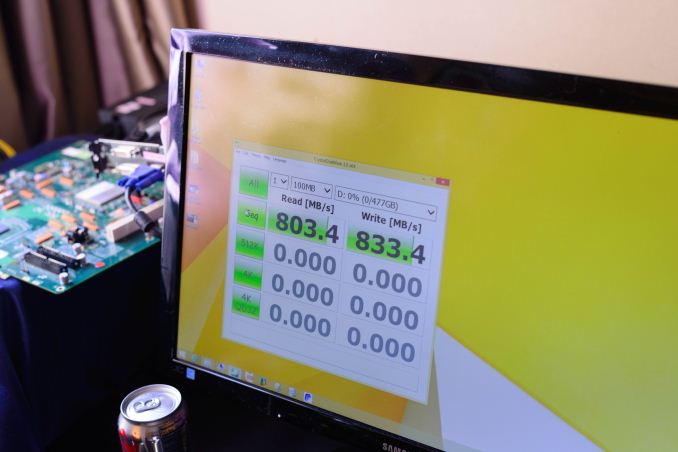
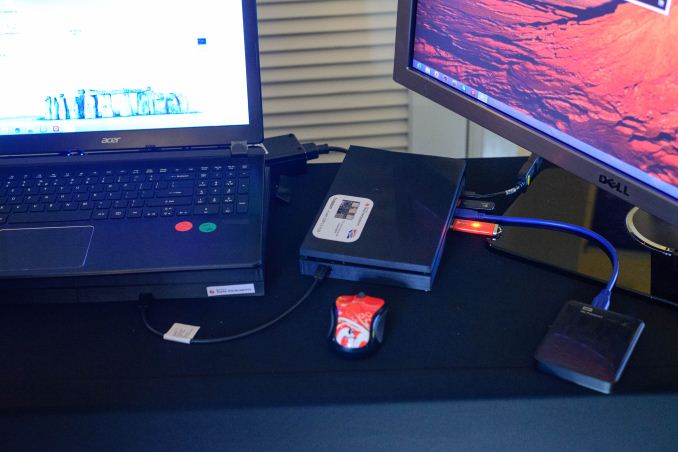
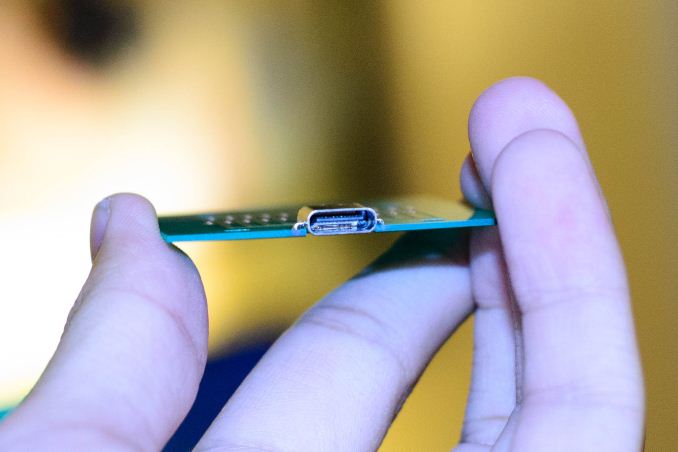
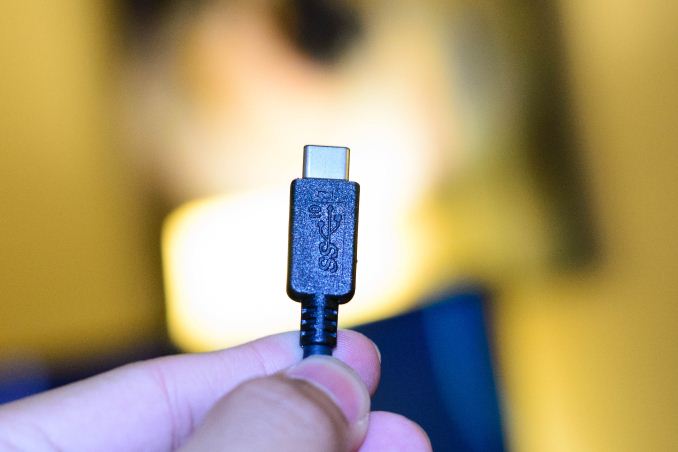
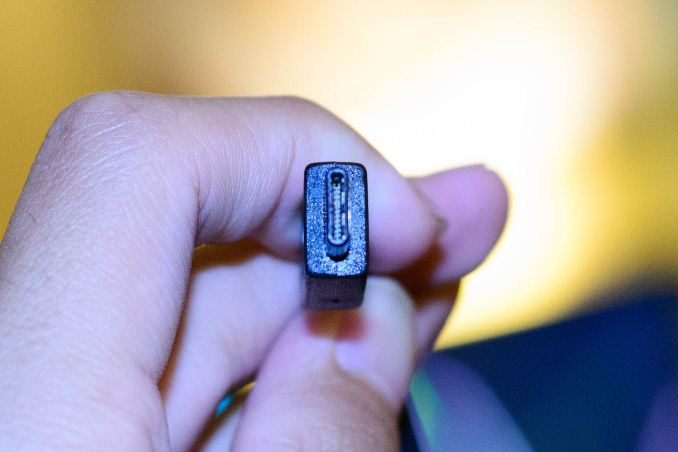








91 Comments
View All Comments
fokka - Thursday, September 11, 2014 - link
i had problems with the reliability of micro usb connectors too on my phone for some time. but to be honest, my experiences with mini usb haven't been much better.but then i remembered, that i once had problems getting a good connection with my headphones. it turned out that there was a bit of pocket lint accumulated in the hole over time. i took it out with with my needle nose tweezers, which solved the problem back then.
lo and behold, pocket lint was the culprit with the bad usb connection too! it took a couple minutes to ply and scratch and blow it all out, but now my usb cables work like champs again!
you should power down your device when performing this operation though and maybe even take out your battery, if that's possible, otherwise you risk shorting out the contacts to ground.
maybe it's the same thing with your devices?
evilspoons - Thursday, September 11, 2014 - link
Micro-USB cables are fragile on purpose so they don't destroy the connectors on the PCB in your devices, like what happened continuously with Mini-USB. Much easier to replace a $3 cable a couple time than re-solder a USB connector to your phone's mainboard.Jumpman23 - Thursday, September 11, 2014 - link
I feel the lightning connector is perfect in terms of durability and size. There's nothing in the female port itself unlike the microusb female connector so you could jam the male side in harder without worrying about breaking off the pins on the inside.rGiskard - Friday, September 12, 2014 - link
I believe the word you're looking for is "thrust," as in "you could thrust the male side in harder and harder without worrying...":P
C@illou - Friday, September 12, 2014 - link
I think USB Type C connector should have less disconnection issues (not that I ever had any). They have pins on both sides, this redundancy should make them more reliable (i.e. when moving the connector, there are less chance of disconnecting both opposed pins than disconnecting a unique pin).wrkingclass_hero - Friday, September 12, 2014 - link
Yes! Micro usb is terrible! Type C looks bad too, I wish they had stuck with the mini usb form factor. Please make an article addressing these issues.TrackSmart - Saturday, September 13, 2014 - link
In response to Jarred: Every microUSB car charger I've ever owned has failed at the connector after some amount of use. And it was definitely NOT an issue with dirt/lint/corrosion. I now buy car chargers that have removable cables for *when* (not if) they start having connectivity problems. The car charger is a worst-case scenario for a microUSB cable. It is often being tugged on and the phone is physically resting on the cable connection when sitting in someone's cupholder.SUMMARY: The male ends of MicroUSB cables are definitely NOT robust. But I've never had problems with the internal socket on a phone or other gadget. I hope both sides of the connection are more robust this time around.
flatrock - Monday, September 15, 2014 - link
My daughter went through quite a few lightning cables for her iPhone 5. She has learned to treat the cables a bit more delicately and hasn't had one go bad for a while. I also quit buying cables directly from Apple, since Apple's appear to be cheaply made and not particularly durable.I've had a number of micro-usb cables go bad, as well, but mostly because abuse like getting stepped on on the car floor and having the connector bent, which no small cable can survive.
Samuel Lord - Thursday, September 18, 2014 - link
Yes, micro-USB is a nightmare for anyone using it over a few hundred cycles (um, smartphones). It was claimed to be better than Mini USB but is simply garbage. Actually *any* nonlocking connector for high speed data is garbage: remember how DP was advertised as locking when it came out? Lies, lies...sigh. Actually HDMI is the *very* worst, if you blink it falls out. Thunderbolt is made with tighter specs, but they *all* fail the lock test unless you buy a $$$ locking connector cable.ytg137 - Monday, December 8, 2014 - link
I've had a number of micro-USB chargers or connectors fail. I've never been sure whether someone stepped on the tip, or why they stopped working.And you're right... I've never had a failure with the previous types of chargers/connectors. However, my husband & son in law bought the Samsung Note 3 last fall. The chargers have USB 3.0 Micro B connectors. Both of their chargers failed in less than a year. I don't know if this is a reflection on Samsung's manufacturing, or on the durability of this type of wire.